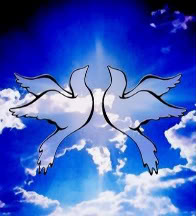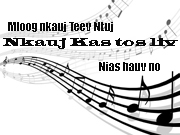Maiv Tooj wrote:Tswv Ntuj tsim tib neeg, nws tsim ib lub cev thiab tus plig.
Tswv
Ntuj tsim tib neeg, nws tsim muaj ib lub cev thiab ib tug plig. Tus
plig nws nyob mus li, tsis txawj tuag, peb neeg yaj ceeb tsis pom thiab
kov tsis tau nws.
Thaum Tswv Ntuj tsim Adas, nws tsim muaj lub cev thiab tus ntsuj plig.
Lub cev peb pom thiab tes kov tau.
Tab sis cov tsiaj ntxhu mas muaj lub cev xwb, tsis muaj ntsuj plig.
Leej neeg thaum nws teev Ntuj nws tsis pom Tswv Ntuj, tab sis Tswv Ntuj pom nws thiab hais lus rau nws.
Tej tsiaj ntxhu tsis paub Tswv Ntuj, lawv tsis txawj teev Ntuj, vim lawv tsis muaj ntsuj plig.
Zaj teev Ntuj: Kuv ua koj tsaug Tswv Ntuj, uas koj muab ib lub cev thiab ib tug ntsuj plig rau kuv.
Tais Tooj,
Nyob nyob kuv mam tuaj pom koj qhov post uas koj hais txog tias "...cov tsiaj txhu mas muaj lub cev xwb, tsis muaj ntsuj plig... Tej tsiaj txhu tsis paub Tswv Ntuj, lawv tsis txawj teev Ntuj, vim lawv tsis muaj ntsuj plig." Kuv yuav tuaj cuam tshuam koj me ntsis. Kuv tuaj qhib ib lub post tshiab, vim kuv tsis paub xyov nws puas zoo tuaj sib tham nyob hauv koj lub tsev Qhia Kev Cai.
Raws li kuv to taub mas lub Koom Txoos yeej ib
txwm tsis tau txiav meej tias tsiaj txhu tsis muaj ntsuj plig. Txheej
thaud mas tej kws txuj tau hais tias tsiaj txhu tsis txawj xav tswv yim
tsis txawj txiav txim tsis muaj "reason" yog li mas tsiaj txhu tsis
muaj ntsuj plig no. Ces lub Koom Txoos kuj tsis tau hais dab tsi los
cuam tshuam cov kws txuj, vim lub Koom Txoos los tsis to taub txog cov
tsiaj txhu meej. Tej zaum lub Koom Txoos kuj tau siv tej kws txuj tej
lus los qhuab qhia txog kev ntseeg.
Ntawm kuv xav mas kuv xav tias tsiaj txhu yuav tsum muaj ntsuj plig
thiab no. Tej zaum nws tus ntsuj plig yuav txawv neeg tus ntsuj plig,
tiam sis nws yuav tsum muaj ib tug ntsuj plig no. Vim tej tsiaj txhu
yeej txawj muaj kev hlub ib yam li neeg thiab. Peb yeej pom tej tsiaj tu
lawv tej me nyuam cuag li neeg tu thiab tej tsiaj yeej txawj muaj kev
tu siab los kua muag ntsoos. Tsis tas li ntawd xwb tej tsiaj xws li dev
los miv txawj muaj kev hlub nrog neeg, paub thiab ncawg nws tus tswv,
tej zaum tseem cawm tau tus tswv txoj sia los lawm.
Hais txog ntawm tsiaj txhu tsis paub Tswv Ntuj. Mas kuv xav hais tias
tsiaj txhu paub Tswv Ntuj zoo kawg li, thiab tej zaum tsiaj txhu tseem
yuav xub pom tau Tswv Ntuj sai tshaj tib neeg no. Nyob hauv Ntawv Ntshiab Xam Phaj 22: 22-35 piav txog Npas Las Has caij nws tus maum luj mus txog ntawm ib ncua kev, tus luj pom Tswv Ntuj tus tshiab thaiv kev, ces nws lug kev thawj zaug, zaum ob nws mus ti ti phab ntsa ces txhuam Npas Las Has txhais taw, zaum peb ces maum luj cia li pw hauv av lawm xwb. Yog li kuv xav hais tias tsaij yeej paub muaj Tswv Ntuj nod...
Kuv mus tshawb tau ib zaj uas yog lawv tau sau nyob hauv ib tsab xov xwm Kas Tos Liv hu ua The Ark rau peb nyeem:
Catholic-AnimalsTHE ARK
A Publication of
THE CATHOLIC STUDY CIRCLE
FOR ANIMAL WELFARE
From The Ark, No 186 Winter 2000
Do Animals Have Souls?
By Deborah Jones
'Only humans matter: they have souls. Animals don't.' This has been said, millions
of times. People often use it as a mantra, not because they are necessarily helping to
alleviate human suffering, but to justify their lack of concern and compassion for the
suffering of animals. Of course humans matter - but so do animals: and animals have souls
too.
Catholic teaching has never actually denied this, following St Thomas Aquinas in
this as in most things, although it has not yet developed a fully positive understanding
of the place of animals within the order of salvation. This is a subject being grasped by
some of the best theologians of our time, as they realise that this lack of understanding
results in an untypically muddled response from the Catholic Church over an important
contemporary issue - that of animal welfare.
The first thing to unravel from the various strands of tradition is the meaning of
the word 'soul'. It is not really helpful to talk of people or animals 'having' souls - as
you might 'have' a wristwatch or brown eyes or curly hair. Body and soul are not simply
two factors existing alongside or in each other, but form an indivisible whole. A person,
or an animal, is wholly body and wholly soul and both are at all times the whole being. In
other words we do not only 'have' a body, or 'have' a soul - we are both body and soul.
The Hebrew language does not talk of the two as separate entities, as we shall see in the
Scriptures. Pagan Greek and Roman philosophers, whose thinking played such a leading role
in influencing Christian theologians through the ages, did make the separation between
spirit and matter, placing reason and soul in the higher, spiritual sphere, and according
body and matter a much lower status. We shall see how this came to effect the way in which
animals, and the rest of the nonhuman creation, came to be viewed.
Living souls
In the beginning of our Scriptures, we see God creating 'every living creature'
(Genesis 1:21, 24). The Hebrew words (transliterated) are 'chay' (living) and 'nephesh'
(soul). 'Nephesh' is mentioned over 400 times in the Old Testament signifying soul. The
words 'chay nephesh' are used from chapter one, verse 20, when the waters are filled with
living creatures. The close translation from Hebrew is: 'And God said: Let the waters
swarm [with] the swarmers [having] a soul of life …' and in the next verse: 'And God
created the great sea animals, and all that creeps, [having] a living soul …' (The
words in square brackets are not used in Hebrew, but are understood.) In verse 30, God
provides food - purely vegetarian - to every living thing, in which, the Hebrew adds,
'[is] a living soul'. There is a definite separation here between 'every green plant',
which of course are living things, and every creature possessed of a 'living soul'. In
chapter two, the second, and older Creation account, the first human being was created
from dust, then God 'blew into his nostrils [the] breath of life and man became a living
soul', a 'chay nephesh'. Here we have the real sense of 'nephesh', or soul, as a being
animated by the breath of life. This reminds us of the glorious invocation of psalm 150,
where 'everything that breathes' is to praise the Lord.
Pope John Paul II: 'animals possess a soul'
When Pope John Paul II declared in a public audience in 1990 that 'also the
animals possess a soul and men must love and feel solidarity with our smaller brethren'
some people must have thought this was a new teaching, unaware of the Holy Father's
scholarly familiarity with the authentic Hebrew texts. When he went on to state that all
animals are 'fruit of the creative action of the Holy Spirit and merit respect' and that
they are 'as near to God as men are', animal lovers in the audience were ecstatic! The
Pope mentions the special relationship of mankind with God as being created in His image
and likeness. 'However,' he goes on 'other texts state that animals have the breath of
life and were given it by God. In this respect, man, created by the hand of God, is
identical with all other living creatures. And so in Psalm 104 there is no distinction
between man and beasts when it reads, addressing God: " … Thou hidest thy face,
they are troubled: thou takest away their breath, they die, and return to their dust. Thou
sendest forth thy spirit, they are created: and thou renewest the face of the earth."
The existence therefore,' the Holy Father reminds us, 'of all living creatures depends on
the living spirit/breath of God that not only creates but also sustains and renews the
face of the earth.'
This discourse caused a stir around the world, and was especially encouraging to
Catholic animal welfare groups which had begun to despair that anything 'animal friendly'
would ever be heard in Rome. The then professor of theology and dogma at the University of
Urbino, Carlo Molari, called it 'very important and significant. It is a "sign of the
times" because it demonstrates the Church's desire and deep concern to clarify
present confused thinking and attitudes towards the animal kingdom. There should be no
need, but the Pontiff, in reiterating that animals came into being because of the direct
action of the "breath" of God, wanted to say that also these creatures, as well
as man, are possessed of the divine spark of life and that living quality that is the
soul. And are therefore not inferior beings or only of a purely material reality.'
The image of God
In the ten years that have passed, not a great deal has changed in church-goers'
understanding of the souls of animals. Could that be because so little is ever taught or
preached or prayed about them and their undoubted suffering at human hands? More is known
about mankind being 'made in the image of God' and about having 'dominion' over the
natural world. That is too often used as justification for treating the world as one great
natural resource for human benefit, and all the other creatures in it as designed for
mankind alone.
But what did 'image' really mean? Statues, or images, were and are used to
represent kings and rulers. Think of the number of statues of Queen Victoria there are
scattered around the former Empire. Human beings are living statues, living
representatives - in much the same way as ambassadors represent the head of state of the
country they come from. We human beings are to represent the rule of God in the created
world, using delegated powers to see that the world continues to function and flourish in
the way the Creator intended. To be shepherd-kings, not 'as those who are supposed to rule
over the Gentiles lord it over them', but as 'slave of all' (Mark 10: 42-45). St Francis
came close to this model in treating all other created beings as 'brothers and sisters',
rather than as most people do today, as disposable things whose only value is in their
usefulness to us.
We have elevated the human being beyond all other creatures until he has even
taken the place of God. Secular rationalism would do away with the concept of soul
altogether. The French philosopher, Descartes (1596-1650), divided the human person into
the 'thinking part' res cogitans and the body res extensa. He saw the body as a machine,
which had to be governed by the self-awareness of human rational thought. He dropped the
word for soul 'anima' and replaced it with the word for mind 'mens' What animals lacked,
so he said, was the human rational thought, therefore their status was purely that of
machines - and machines cannot feel. The screams emitted by tortured animals were no more,
he said, than the squeaking of mechanical parts and of no consequence. That attitude to
some extent still exists, even though scientists are now discovering that even relatively
simple life forms are capable of feeling pain and stress.
The Age of Reason was typified by Descartes and by Kant, who wrote that 'So far as
animals are concerned we have no direct moral duties; animals are not self-conscious and
are there merely as a means to an end. That end is man.' For them might have been written
those chapters in Job in which God asks: 'Where were you when I laid the foundation of the
earth?' (chapters 38 and 39). However, they had been influenced more by Aristotle and the
Stoics than by Scripture. These ancients held that animals, while possessing 'animal
souls' (as distinct from 'vegetable souls') lacked reason, and demonstrated their lack of
reason by lack of speech. They were not to know of the complex communication abilities of
many of the primates, dolphins, whales, etc. What is worse is that they considered that
lack of speech gives us the right to exploit them! Stoics also thought that animals cannot
learn by experience - but then, they never watched 'One Man and his Dog'!
What is definitive in Christian understanding of animals in the order of
salvation, is that, with the incarnation of Christ, with God taking flesh, there is a new
connection between all that shares the matter of flesh, of bodies: as the Holy Father
said, a 'solidarity' between us and our brothers and sisters, the other 'living souls',
the animals.
Txhais ua lus Fab Kis
Catholique-Animaux
L'ARCHE
Une publication de
Cercle d'étude CATHOLIQUE
Pour le Bien-être animal
De l'Arche, n ° 186 L'Hiver 2000
Les animaux ont-ils une âme?
Par Deborah Jones
«Seuls les êtres humains ont l'importance: ils ont une âme. Les animaux n'ont pas." Cela a été dit, des millions de fois. Souvent,
les gens l'utilisent comme un mantra, non pas parce qu'ils
nécessairement aident à soulager la souffrance humaine, mais pour
justifier leur manque d'intérêt et de compassion pour la souffrance des
animaux. Bien sûr, les humains ont l'importance - mais aussi les animaux: les animaux ont une âme aussi.
L'enseignement
catholique n'a jamais nié cette réalité, à la suite de St Thomas
d'Aquin dans ce domaine comme dans la plupart des choses, même si elle
n'a pas encore développé une compréhension totalement positive de la
place des animaux dans l'ordre du salut. C'est
un sujet compris par certains des meilleurs théologiens de notre
temps, car ils réalisent que ce manque de compréhension résulte
dans une réponse untypiquement confus de l'Église catholique sur une
question importante contemporaine - celle du bien-être animal.
La première chose à démêler des différents fils de la tradition est la signification du mot «âme». Ce
n'est pas vraiment utile de parler de personnes ou d'animaux ayant des
âmes - comme on pourrait «avoir» une montre-bracelet ou les yeux bruns
et les cheveux bouclés. Corps et âme ne sont pas simplement deux facteurs existant à côté ou dans l'autre, mais forment un tout indissociable. Une personne ou un animal, est tout à fait corps et âme à part entière et les deux sont en tout temps l'être tout entier. En d'autres termes nous ne sommes pas seulement «avoir» un corps, ou ont «une âme - nous sommes à la fois corps et âme. La langue hébraïque ne parle pas de deux comme des entités distinctes, comme nous le verrons dans les Écritures. Les
philosophes paien grecs et romains, dont la pensée a joué un rôle de premier
plan en influençant les théologiens chrétiens à travers les âges,
furent la séparation entre l'esprit et la matière, en mettant la raison
et l'âme dans le supérieur, spirituel sphère, et selon le corps et la
matière d'un statut beaucoup plus faible . Nous
verrons comment cela est arrivé pour effectuer la façon dont les
animaux, et le reste de la création non humaine, sont venu à etre considéres.
Ames
Vivant
Au début de nos Écritures, nous voyons Dieu créant «tous les êtres vivants» (Genèse 1:21, 24). Les mots en hébreu (translittéré) sont "chay" (vivant) et «nephesh» (l'âme). «Nephesch» est mentionné plus de 400 fois dans l'Ancient Testament. Les mots «nephesh chay 'sont utilisés par le premier chapitre, verset 20, lorsque les eaux sont remplis de créatures vivantes. La
traduction proche de l'hébreu est la suivante: «Et Dieu dit: Que les
eaux [grouillent de] grouillementss [] ayant une âme de la vie ... et dans
le verset suivant:« Et Dieu créa les animaux grands de mer, et tout ce qui
rampe, [avoir]
une âme vivante ... »(Les mots entre crochets ne sont pas utilisés en
hébreu, mais sont compris.) Dans le verset 30, Dieu fournit de la
nourriture - purement végétarien - à tout être vivant, dans lequel,
l'hébreu ajoute:« [ est] une âme vivante ». Il
ya une séparation définitive entre ici «toute herbe verte, ce qui bien
sûr sont des êtres vivants, et tous les êtres en possession de l'âme
vivante». Dans
le chapitre deux, le second, et compte plus de création, le premier
être humain a été créé de poussière, puis Dieu insuffla dans ses narines
[le souffle] de la vie et l'homme devint une âme vivante », nephesh
chay 'A'. Ici, nous avons le sens réel de «nephesh, ou de l'âme, comme un être animé par le souffle de vie. Cela nous rappelle l'invocation glorieuse du Psaume 150, où «tout ce qui respire est à louer le Seigneur.
Pape Jean-Paul II: «Animaux ont une âme»
Lorsque
le Pape Jean-Paul II a déclaré dans une audience publique en 1990 que
«aussi les animaux possèdent une âme et les hommes doient aimer et se
sentent solidaires avec nos frères plus petits" certaines personnes
doivent avoir pensé que c'était un nouvel enseignement, ignorant la
familiarité scholaire du Saint-Père avec les textes hébreux authentique. Quand
il a poursuivi en déclarant que tous les animaux sont des «fruits de
l'action créatrice de l'Esprit Saint et qu'ils meritent le respect" et qu'ils
sont« aussi près de Dieu que les hommes sont," les amoureux des animaux
dans le public étaient ravis! Le pape évoque la relation particulière de l'humanité avec Dieu comme étant créés à son image et ressemblance. «Toutefois," poursuit-il «d'autres textes affirment que les animaux ont le souffle de vie et q'elle leur était donnée par Dieu. À cet égard, l'homme, créé par la main de Dieu, est identique à toutes les autres créatures vivantes. Et
dans le Psaume 104 Il n'ya pas de distinction entre l'homme et les
bêtes quand il lit, s'adressant à Dieu: '... Tu caches ta face, ils sont
troublés; tu enlèves leur souffle, ils expirent et retournent à leur
poussière. Tu envoies ton esprit, ils sont créés, et tu renouvelles la face de la terre.' L'existence
donc," le Saint-Père nous rappelle,« de tous les êtres vivants dépend
de l'esprit de vie / le souffle de Dieu qui ne crée pas seulement, mais
soutient également et renouvelle la face de la terre."
Ce
discours a fait grand bruit dans le monde entier, et a été particulièrement
encourageant pour les groupes catholiques du bien-être animal, qui avait commencé
à désespérer que tout ce qui est animal «amis» ne serait jamais entendu à Rome. Le
professeur de la théologie et du dogme à l'Université
d'Urbino a ce temps la, Carlo Molari, a appelé cela "très important et significatif. Il
est un 'signe des temps', car elle démontre la volonté et la profonde préoccupation de l'Eglise pour clarifier les
pensees et les attitudes confus presentment envers le règne animal. Il
devrait y avoir aucun besoin, mais le Souverain Pontife, en réitérant
que les animaux a vu le jour en raison de l'action directe du «souffle»
de Dieu, voulait aussi dire que ces créatures, ainsi que l'homme, sont
en possession de l'étincelle divine de la vie et que la qualité de vie qui est l'âme. Et ne sont donc pas des êtres inférieurs ou seulement d'une réalité purement matérielle.
L'image de Dieu
Dans les dix années qui ont passé, pas beaucoup a changé dans la compréhension de dévots de l'âme des animaux. Serait-ce
parce que si peu est toujours enseignée ou prêche ou prie sur eux
et leur souffrance incontestable aux mains de l'homme? On en connait davantage sur l'homme étant «fait à l'image de Dieu» et d'avoir «domination» sur le monde naturel. C'est
trop souvent utilisé comme justification pour traiter le monde comme
une grande ressource naturelle au bénéfice de l'homme, et toutes les
autres créatures comme conçus pour les hommes seuls.
Mais qu'est-ce que «l'image» signifie vraiment? Statues, ou des images, ont été et sont utilisés pour représenter les rois et les gouvernants. Pensez au nombre de statues de la reine Victoria, il y sont dispersés autour de l'ancien Empire. Les
êtres humains sont des statues vivantes, vivants représentants - dans une grande
partie de la même manière que les ambassadeurs représentent le chef de
l'Etat du pays dont ils proviennent. Nous,
êtres humains sont appelés à représenter la volonté de Dieu dans le
monde créé, en vertu des pouvoirs de voir que le monde continue à
fonctionner et prospérer dans la façon dont le Créateur a voulu. Pour
être rois pasteurs, et non pas «comme ceux qui regnent
sur les Gentils, dominent sur eux, mais comme« l'esclave de tous »(Marc
10: 42-45). Saint-François
est venu près de ce modèle dans le traitement de tous les autres êtres
créés comme des «frères et sœurs», plutôt que comme la plupart des gens
le font aujourd'hui, comme des choses jetables dont la seule valeur est
dans leur utilité pour nous.
Nous avons élevé l'être humain au-delà de toutes les autres créatures jusqu'à ce qu'il ait même pris la place de Dieu. Le rationalisme seculaire voudrait supprimer le concept de l'âme completement. Le
philosophe français Descartes (1596-1650), divisait la personne humaine
dans le cadre de la pensée «res cogitans et res extensa corps. Il a vu le corps comme une machine, qui devait être régi par la conscience de soi de la pensée rationnelle de l'homme. Il
a laissé tomber le mot pour l'âme «anima» et l'a remplacé par le mot
esprit »mens» Ce que les animaux n'avaient pas, disait-il, est la
pensée de l'homme rationnel, par conséquent, leur statut était purement
celle des machines - et les machines ne peuvent pas se sentir. Les cris émis par les animaux ne sont pas plus tourmenté, dit-il, que le grincement des pièces mécaniques et sans conséquence. Cette
attitude dans une certaine mesure existe toujours, même si les
scientifiques sont en train de découvrir que même les formes de vie
relativement simples sont capables de ressentir la douleur et le stress.
L' Age de Reason a été caractérisée par Descartes et par Kant, qui ont écrit
que «Pour autant que les animaux sont concernés, nous avons aucun droit
moral direct, les animaux ne sont pas auto-conscient et ne sont là que
comme un moyen vers une fin. Cette fin, c'est l'homme. Pour
eux, auraient pu être écrits ces chapitres dans Job où Dieu demande:
«Où étais-tu quand je posais les fondements de la terre? (Chapitres 38 et 39). Cependant, ils avaient été plus influencés par Aristote et les Stoïciens que par l'Écriture. Ces
anciens considéraient que les animaux, tout en possédant des âmes animaux
"(par opposition aux« âmes de légumes ») n'avaient pas raison, et la
preuve de leur manque de raison etait par leur manque de parole. Ils
n'étaient pas de connaître les capacités de communication complexes de
la plupart des primates, les dauphins, baleines, etc Ce qui est pire,
c'est qu'ils ont estimé que l'absence de la parole nous donne le droit
de les exploiter! Stoïciens
ont aussi pensé que les animaux ne peuvent pas apprendre par l'expérience -
mais alors, ils n'ont jamais regardé "Un homme et son chien»!
Ce
qui est définitif dans la compréhension chrétienne des animaux dans
l'ordre du salut, c'est que, avec l'incarnation du Christ, avec Dieu en
prenant chair, il ya une nouvelle connexion entre tous ceux qui prennent part dans
la question de la chair, des corps: comme le Saint-Père a déclaré , une «solidarité» entre nous et nos frères et sœurs, «les autres» âmes vivantes, les animaux.















 Yog koj tso siab rau Yesxus lub siab ntshiab, nws yuav ua koj siab kaj lug
Yog koj tso siab rau Yesxus lub siab ntshiab, nws yuav ua koj siab kaj lug 







 Vim li cas peb cov Kas Tos Liv ntseeg tias NIAM MAB LIAB yog TSWV NTUJ Niam? caws nej mus nias nyeem tau hauv no.
Vim li cas peb cov Kas Tos Liv ntseeg tias NIAM MAB LIAB yog TSWV NTUJ Niam? caws nej mus nias nyeem tau hauv no. Leej Tshiab Mis Kas Ees thov koj pab tuav thiab saib xyuas peb lub Vas Sab Hmong Catholique ntawm no kom ruaj nrees.
Leej Tshiab Mis Kas Ees thov koj pab tuav thiab saib xyuas peb lub Vas Sab Hmong Catholique ntawm no kom ruaj nrees.






